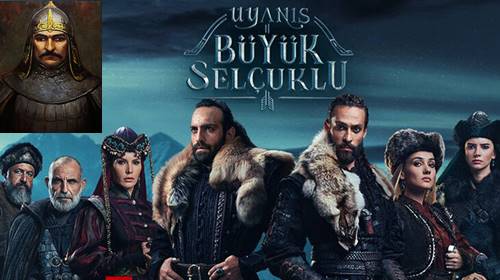'Uyanış Büyük Selçuklu': What Is The Series About?
What is the story of Uyanış Büyük Selçuklu? When the Period is? Who is Sultan Melikshah? Here is the place and importance of Sultan Melikshah in history...
Sultan Melikshah, one of the rulers of the Great Selchulu State, left Nizamülmülk, whose father was appointed queen at the time, after becoming sultan in 1072. The Seljuks lived their brightest period during the Melikshah period. Here is the information about the life of Sultan Melikshah, who was also mentioned in the series Uyanış Büyük Selçuklu...
Who Is Sultan Meliksah?
Full name of Sultan Melikshah is Ebü'l-Feth Celâlü'd-devle ve'd-dîn Muizzü'd-dünyâ ve'd-dîn Kasîmü emîri'l-mü'minîn Melikşâh. Sultan Melikshah, ruler of the Great Seljuk State, was born on August 16, 1055 and died on November 19, 1092.
During the reign (1072-1092), the Great Seljuk State reached its widest borders. Borders stretched from Anatolia to Oman from the Caucasus to India (10,000,000 km2). After Melikshah, the Seljuks did not regain their strength. Among the most important people of the era, Omer Hayyam is in the field of science and Nizamülmülk politics.
Before He Became Sultan
Melikshah was born on Sunday, August 16, 1055. He spent his childhood in isfahan and the vicinity. His father, Alparslan, was closely involved with Melikshah, who was noted for his ability and courage. Melikshah is portrayed as tall, slightly fat and white-skinned.
 |
| Image Via www.trt1.com.tr |
Melikshah joined the Georgian campaign with his father at a young age. In the same year, he was married to Terken Hatun, the daughter of Karahanlı Khan. Alparslan appointed Melikshah as heir in 1066 and was given the city of Isfahan as "Ikta (or Timar)".
In 1071, he and his father Alparslan made an expedition to Syria. His father headed north to stop the advance of the Byzantine Emperor Romanian Diyogen in Anatolia (and fduring the Battle of Malazgirt Square). Melikshah remained in Aleppo, Syria. In 1072, his father was with him while he was making an expedition against the Karahans. He was martyred by Yusuf Harzemi, a Karahan castle commander whose father took him prisoner this time.
Melikshah beed head of the Seljuk army and proclaimed his Sultanate. Mr. Cagri's uncle Kavurt Bey, who was Mr. Cagri's son, refused to accept Melikshah to be sultan. Melikshah walked west into Iran with The Lyzir Nizam-ul Mülk next to him. On April 17, 1073, he entered the "Battle of Karaç" near Karaç (now "Erak" in Iran) with Mr. Kavurt's army. In this battle, many Turkmen soldiers in Melikshah's army joined Mr. Kavurt's army during the battle. However, Melikshah and his army prevailed. Mr. Kavurt was executed and his two sons were pulled in the eyes and blinded. Thus, among the orders in the Seljuk country was designated as Melikshah Sultan. In 1074, he officially proclaimed that Melikshah, the new Abbasid caliph in Bagdad, was the Sultan.
Sultan Meliksah Period (1072-1092)
In the early years of his execution, his uncle Kavurt, who had rebelled twice and was pardoned during the time of Sultan Alparslan, rebelled again. This rebellion was suppressed and Kavurt was strangled with the beam of the broadcast and executed. The Karahans captured the area up to Melikşâh Semerakant, who marched to his country. Kinship was established between both dynasties. The Wraths were the same fate and had to accept the high domination of Melikşâh.
He sent Suleyman Şâh, the son of Kutli, to Anatolia and appointed him as an emer to this country. His son Suleyman Şâh soon took over all of Anatolia. Izmit laid the foundation of the Anatolian Seljuk Dynasty as the capital (1077). At the time of the melikşâh, the Seljuk Empire reached its widest limits. It was reached from the Seyhun River and God Mountains to the east to the Mediterranean and Straits to the west, and from the Caucasus Mountains to the South to the Indian Sea.
One of the most important internal events of the period of melikşâh is the Western movement of Hasan Sabbah. Hasan Sabbah established a cult with the lying paradise he established in Alamut Castle and began to assassinate the bouncers of his cult against many Turkish and Muslim foremans. Sultan Melikşâh, who dealt with the Westerners in the last years of his death, died of poisoning at the age of 38 (1092).
The Disintegration Of The Great Seljuk Empire
Shortly after sultan Melikşâh's death, Lyzir Nizam'ul-Mülk was also killed by the Westerners. The Empire was torn apart as Kirman Seljuks, Syrian Seljuks and Anatolian Seljuks, depending on the Great Seljuk Sultans of Iraq and Khorasan. After Melikşâh, his 5-year-old son Mahmoud was removed to the throne, but Berkyaruk did not recognize him.
Berkyaruk also died in 1104. His brother Mohammed Tapar (1105-1118) ascensed to the throne in Isfahan. After Tapar, sultan Sançar (1118-1157), the last great ruler of the Seljuk State, ascensed to the throne. He re-taxed the Gurlus, the Karahans, the Harezmshahs. He again put an end to the caliph's efforts to seize political power, thingring out only religious duties to Him. However, he lost to the Karahıtays in Katvan in 1141. This defeat was a turning point for Sultan Sançar and he could not meet again. In 1153, he became a prisoner of the nomadic Ouzs. Sultan Sançar, who was rescued after three years of captivity, died in 1157 at the age of 72.
Read Also All Episode of Uyanış Büyük Selçuklu
Post a Comment